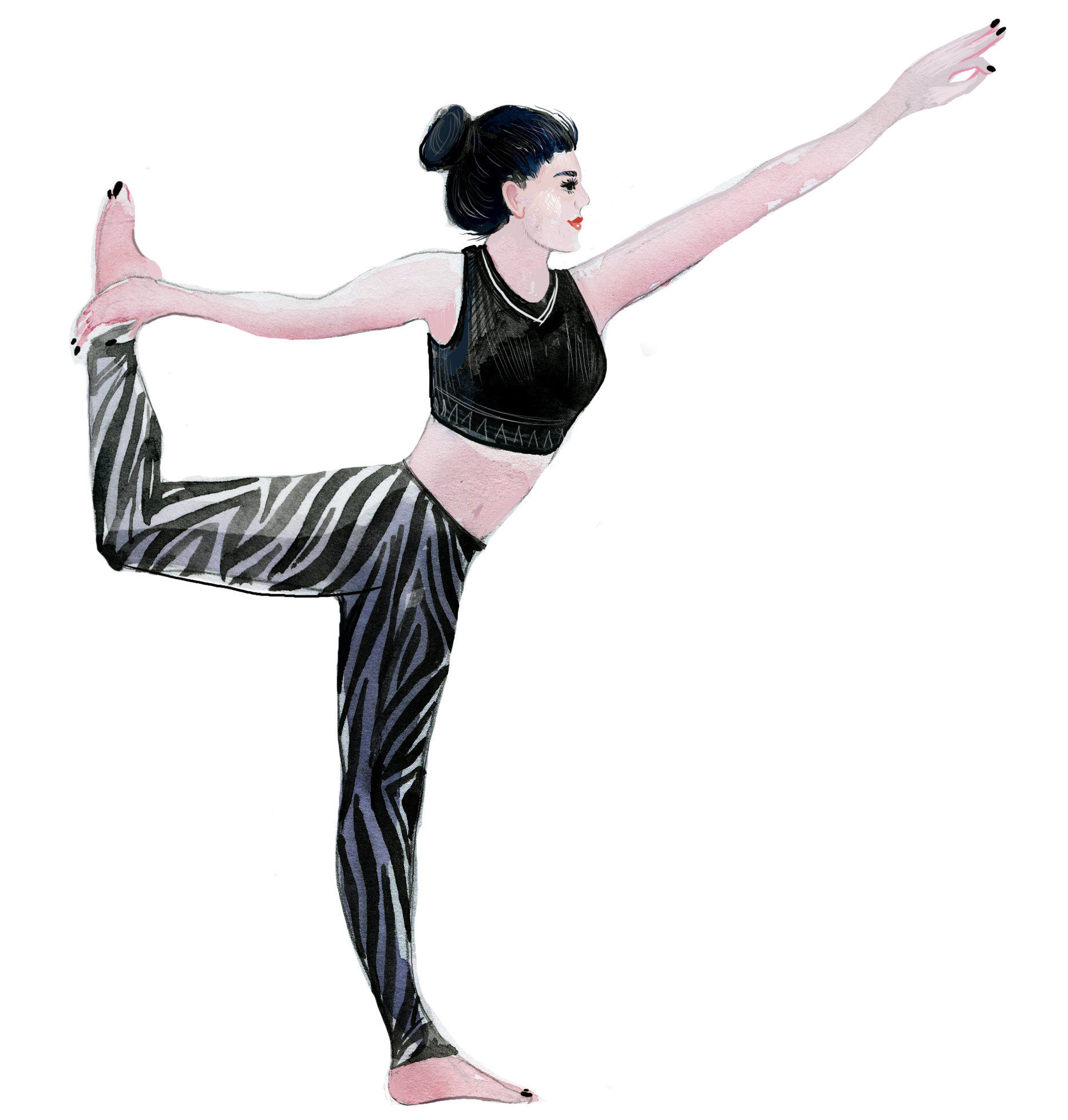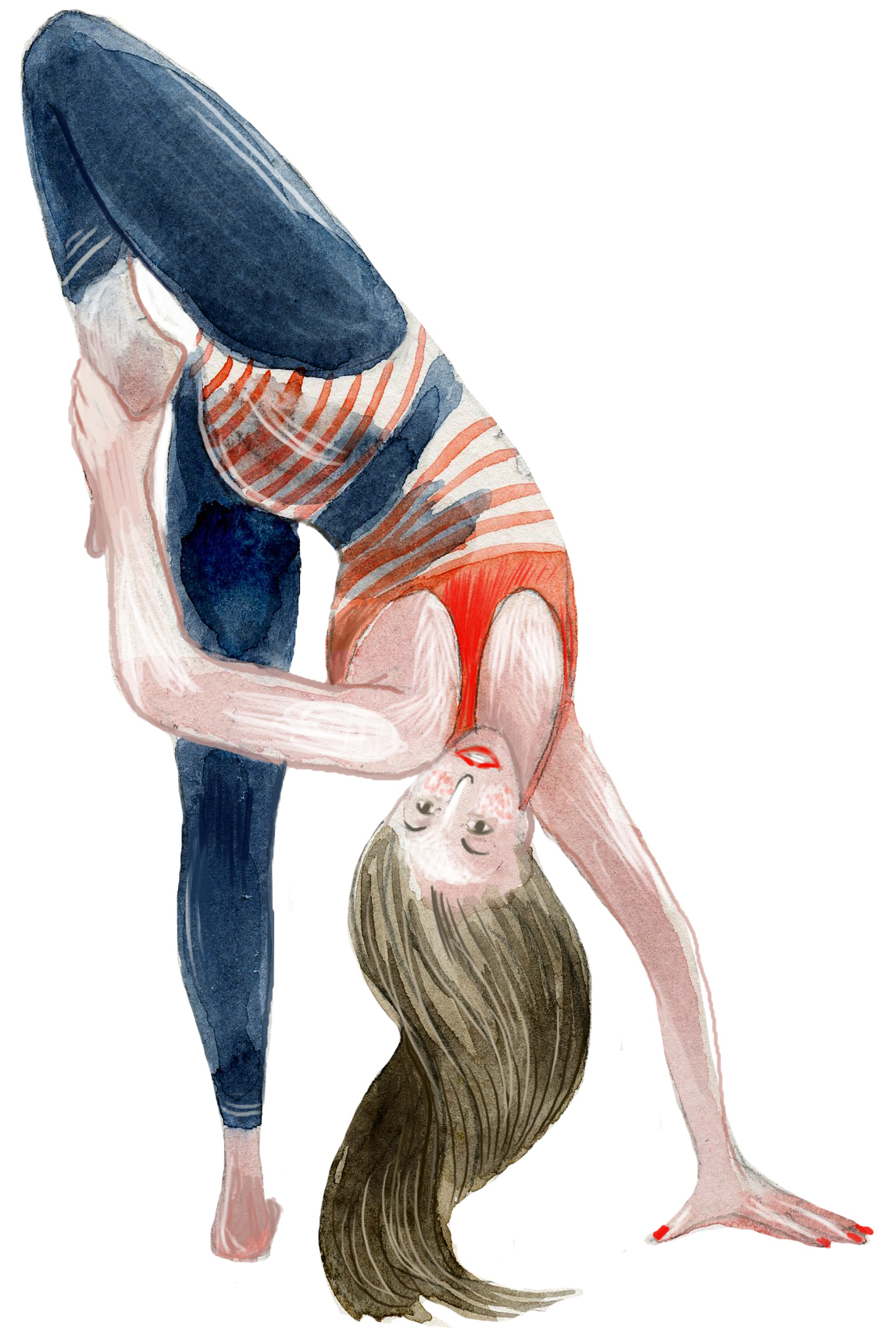I remember my early days of yoga to be an attempt in just keeping my pants up, not to mention slipping and falling on a borrowed mat in a pool of my own sweat.

Back in the day, if you popped into a yoga room, it was a sea of black interspersed with various and sundry gym wear. There were no yoga outfits per se, and we could barely keep our trousers up in Downward Facing Dog (“DD“). Forget about inversions in those awful pants.
Those pilling black and faded semi-sweat breeches did nothing for our yoga practice. You could say that I had to adjust my gear probably as many times as I lowered half way down to Chaturanga which, by the way, was and is the biggest cheat pose in yoga. If there is no lengthening of the tailbone to find the lower abdominals, the pose ends up looking like one’s butt is on holiday while everything else is lowering.
Back to those annoying black lower body coverings which were now in rotation for more than just Sunday am laundry and bad breakups. The old school running trousers were out in full force in the yoga room. Those old black hole-y and faded pantaloons were not the only things in vogue back in the day on a borrowed mat. Before yoga was in mass appeal, there was the ubiquitous beach towel. Beach towels in yoga class you say? Why yes, if you are a consummate, award-winning bona fide sweatbox like me, you simply walked into the yoga room and started sweating buckets long before the class began. As we started to move from Cow-Cat and using more arm and leg strength, I found that my sweatbox would begin to pour large drops of perspiration onto the mat. Consequently, I could barely stand up without slipping on my mat.
 That’s when I decided to start bringing beach towels to cover my mat. The problem with the beach towels was two-fold. First, the towels were not thick enough to absorb my rapidly pouring waterfall of sweat. My sweat was so fierce that is practically demanded the opening of new pores.
That’s when I decided to start bringing beach towels to cover my mat. The problem with the beach towels was two-fold. First, the towels were not thick enough to absorb my rapidly pouring waterfall of sweat. My sweat was so fierce that is practically demanded the opening of new pores.
These new pores seemed to unfurl like flowering plants open upon first rainfall after a five year California drought. Second, the beach gear, unfortunately, was too thick to allow an even transition back to DD before Side B started or even a new sequence. Additionally, once the beach towels were saturated, they became more like a “Slip and Slide” in yoga class. You can just imagine my delight when Yogitoes unveiled their anti-slip mat covers with tread on the back of each mat cover. Pure yoga genius!

At some point, clothing manufacturers realized that there was a largely untapped market for fashionable yoga gear… Some subdued colors and prints started to come into vogue. There was still the issue of the falling yoga pant, the underwear riding up and the camel toe experience from lifting the pants or trying to tie the ties a little tighter into the gut to prevent falling trousers.
Eventually smaller yoga clothing manufacturers started coming on the scene and making pants which promised not to move during practice. Lululemon, a premium women’s athletic wear brand, started making a patented brand with 86 % nylon and 14% lycra called “Luon.” This mixture material yoga pant is marketed as “stretchy, breathable and moisture wicking.”
Athleta, another larger retailer of women’s active line also started focusing more on yoga pants. They also came up with special technology for their yoga pant called “Pilayo” which is 88% nylon and 12% Lycra.
Interestingly, Lululemon charges at least $30 more per yoga pant even though they use almost identical fabric configurations in their yoga pant. This fact appears to be related to Lululemon’s popular and now notorious brand. There was also the brief shining moment of the “sheer yoga pant” which took notice as yogins were bent over in Uttanasana standing forward bend. The Lululemon technology engineered pant had the equivalent effect of “mooning” one’s yoga neighbor.

In 2013, this fabric snafu ended up costing the then yoga apparel giant $67 million in revenue.
Whether this was a real hit for the $10 billion dollar yoga empire of Lululemon remains unknown. A second big hit came later that same year in November 2013, when chairman Chip Wilson blamed “women’s bodies for causing problems with their yoga pants.” Wilson said that “Frankly, some women’s bodies just don’t actually work for yoga pants.” (Interview on Bloomberg TV’s “Street Smart.)
In 2015 and after much money down the drain, ex-CEO Wilson regretted his comments. At a press conference, Wilson remarked that his comments about women’s seemingly large bodies not being right for his model image of women in yoga wear led him to say that his comments were “the biggest disaster of my life.”
Fast forward a few years since Wilson was interviewed and there are plenty of fresh new women-owned and smallish yoga wear lines that have cropped up: Kira Grace, Alo, and Altar Ego just to name a few. There is now an onrush of a color explosion, including wearable art, graphic designs, henna’d and laser imprinted with a rainbow of hues for every appetite and mood. In addition to the color metamorphosis, there are some environmentally friendlier versions of yoga pant made from recycled bottles (since most plastic can only be recycled 1-2 x before landfill) and “therapeutic” yoga pants. We highly welcome those therapeutic yoga pants made from seaweed. Now yoga pants claim to be super body con, figure flattering, lifting, smoothing, even controlling the dreaded “muffin top.” Wow!
Yoga pants much like the yoga biz have taken a life of its own. Personally, I am hoping for some yoga pants to catapult me into the ethers.

Illustrations by Ksenia Sapunkova.





